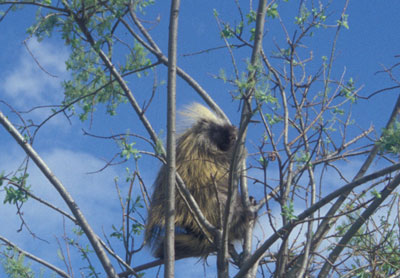There's nothing else like it. Really! Taxonomically, the way scientists assign order to species using Latin names, the North American Porcupine, Erethizon dorsatum, is the only species (dorsatum) in its genus (Erethizon). This large nocturnal rodent has also developed a unique hairstyle in the name of personal protection. Its pelage or fur is a collection of three types of hair: course long guard hairs; a dense woolly undercoat; and the famous tubular hollow quill, which gives it the alternate name of quill-pig. These quills are loosely attached to the porcupine's skin so, although the animal does not throw the quills, quills can come off very easily. And painfully, for the recipient. There are small barbs at the quill tips, which cause the quill to work its way into flesh. Death to a predator can occur if a quill works its way into the wrong body part. Successful porcupine predators, like coyotes, fishers and bobcats learn to attack the porcupine's belly, where there are no quills.
Porcupines, though dangerous, are not aggressive. They are defensive animals; they have no offensive weapons, only defensive quills. These quiet vegetarians wish only to be left alone to eat in peace.
A porcupine's natural diet consists of a variety of plant materials. Their preferred food is the inner bark of hemlock and sugar maple trees, although they will dine on many other species. If the animal girdles a tree – chews all the way around the trunk, interrupting the flow of water and nutrients – the tree may end up deformed or dead. In the spring, porcupines expand their diet to buds and twigs as well as herbaceous plants, fruits and nuts. Based on this diet, you could infer the porcupine's favorite habitat: mixed conifer-hardwood forests and woodlands. They may also be found in shrubland and forested swamps, and even in the desert in parts of their range.
Porcupines are usually solitary, except for mothers with young. A female porcupine will begin breeding at 15 months and will have a single precocious offspring each year in late spring. The baby is born fully formed with open eyes and a full set of teeth. Even its quills, which are soft at birth, harden within an hour. Porcupine young are able to climb soon after they are born; their feet have long curved claws. And even though they can eat solid food immediately, they will nurse for four months. In the winter, a group may share a den, in a hollow tree, downed log or rock outcropping. Porcupines do not hibernate; they are active year-round.
The porcupine is not globally rare or a federally listed species. It is a watchlisted species in Maryland, usually found only in the western part of the state. The porcupine's natural range extends from Alaska across the Yukon Territory and the southern provinces of Canada to the eastern coast, then south through the western United States and the Great Basin to northern Mexico. In the eastern and Midwestern parts of the US, its range extends only through eastern Tennessee and Iowa. It is no longer found in the Southeast; it has been extirpated or locally extinguished in these states.

Why would an animal disappear from part of its range? Part of this can be attributed to the animal itself. Rearing only one young per year is not the most efficient way to increase the population. Just think of other rodents we know who don't seem to have this problem (black rats and house mice come to mind – both prolific breeders with a broad range of acceptable habitats). The condition of the porcupine's habitat may be changing. Their favorite snack tree, the Eastern hemlock, is under attack from an invasive insect, the hemlock woolly adelgid. This tree has been especially hard hit in the southeastern US. Porcupines also require downed logs or hollow trees, some sort of winter cover which although scenic does not contribute to the monetary value of a tree harvest. Modern forestry practices are often geared toward efficiency and maximization of harvest. An understanding of forests as habitat can help us maintain healthy forest ecosystems. Finally, some people consider porcupines a nuisance. In parts of their range, these animals may do damage to alfalfa fields. Porcupines will also gnaw on manmade structures, outbuildings, furniture, even automobile undercarriages. The porcupines are in search of sodium.
Although the porcupine is not in danger of becoming extinct any time soon, it is worth the effort to keep an eye on this solitary creature. Its fate can tell us quite a bit about our relationship with the natural world, a world upon which we humans are still dependent.
- Photograph of porcupine in tree, courtesy of Doug Hotton
